1988년 2월 15일, 미국의 물리학자 리처드 파인만 (Richard Phillips Feynman, 1918 ~ 1988) 별세
리처드 필립스 파인만 (Richard Phillips Feynman, 1918년 5월 11일 ~ 1988년 2월 15일)은 양자역학의 경로 적분 공식화, 양자 전기역학의 이론, 과냉각 액체 헬륨의 초유체 물리학, 그리고 쪽입자 모형을 제안한 입자 물리학의 연구로 유명한 미국의 이론물리학자이다.

– 리처드 필립스 파인만 (Richard Phillips Feynman)
.출생: 1918년 5월 11일, 미국 뉴욕 뉴욕
.사망: 1988년 2월 15일, 미국 캘리포니아 로스앤젤레스
.배우자: 궤네스 하워스 (1960 ~ 1988년), 메리 루이스 벨 (1952 ~ 1958년)
.자녀: 칼 파인만, 미셸 루이스 파인만
.학력: 프린스턴대학 (1939 ~ 1942년), 매사추세츠 공과대학교 (1935 ~ 1939년) 등
.수상: 노벨 물리학상, 미국 국가 과학상 물리학 부문, 알베르트 아인슈타인 상, 외르스테드 메달 등
파인만은 양자 전기역학의 발전에 기여한 공로로 1965년 줄리언 슈윙거, 도모나가 신이치로와 공동으로 노벨 물리학상을 받았다.
파인만은 나중에 파인만 도형으로 알려지게 된 아원자 입자의 거동을 설명하는 수학적 표현을 위해 널리 사용되는 그림 표현 체계를 개발했다. 일생 동안 파인만은 세계에서 가장 유명한 과학자 중 한 명이 되었다. 1999년 영국 저널 《물리학 세계 : Physics World》가 전 세계의 저명한 물리학자 130명을 대상으로 실시한 설문조사에서 그는 역대 7번째로 위대한 물리학자로 선정되었다.
그는 2차 세계대전 중 원자폭탄 개발을 도왔고 1980년대 챌린저 우주왕복선 폭발 사고를 조사한 로저스 위원회의 일원으로 대중에게 널리 알려졌다. 이론물리학에서의 연구와 함께 파인만은 양자 컴퓨딩 분야를 개척하고 나노 기술의 개념을 도입한 것으로 알려져 있다. 그는 캘리포니아 공과대학교에서 이론물리학의 리처드 C. 톨먼 교수직을 역임했다.
파인만은 1959년 《바닥에 공간이 충분하다 (There’s Plenty of Room at the Bottom)》라는 하향식 나노 기술에 대한 강연과 그의 학부 강의 3권으로 구성된 《파인만의 물리학 강의》를 포함하여 책과 강의를 통해 물리학을 널리 대중화했다. 파인만은 또한 《파인만 씨 농담도 잘 하시네!》와 《남이야 뭐라 하건!》의 자서전적인 책들과 더불어 랄프 레이튼 (Ralph Leighton)에 의한 《투바: 리처드 파인만의 마지막 여행》와 제임스 글릭의 의한 전기 《천재: 리처드 파인만의 삶과 과학》과 같은 그에 대한 책들로 알려지게 되었다.
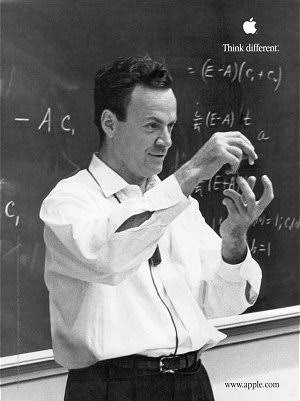
○ 생애 및 활동
리처드 파인만은 1918년 5월 11일 뉴욕시 퀸즈의 작은 마을 파 락어웨이 (Far Rockaway)에서 출생하였다. 어렸을 때부터 단편적인 대답보다는 많은 질문을 통해 생각하는 힘을 기를 수 있도록 유도하는 좋은 선생님의 역할을 하셨던 아버지의 영향을 많이 받았다. 어린시절 라디오를 수리하거나 금고와 자물쇠를 여는 일이 취미였으며 드러머, 화가로서의 재능뿐만 아니라 유머와 재치도 출중하였다.
1939년 MIT를 졸업하고 매사추세츠 공과대학과 프린스턴대학교에서 공부한 후 박사학위를 취득하였다. 제2차 세계대전 중에는 원자폭탄 개발계획인 ‘맨하튼 프로젝트’에 참여하기도 하였다. 전쟁 후인 1945년 코넬대학교에서 이론물리학 조교수로, 1950년 캘리포니아공과대학교 교수로 재직하였다. 그는 1954년 알베르트 아인슈타인상 수상에 이어, 1965년 양자전기역학의 초기공식화에 대한 부정확성을 수정한 연구로 노벨 물리학상을 수상하였다.
파인만이 고안한 파인만 다이어그램은 이후의 이론 물리학에 널리 이용되었으며 20세기 물리학 중 거시적 세계를 아인슈타인이 다루었다면 미시적 세계를 다루는 물리학은 파인만으로 대표될 정도이다. 또한 파인만은 형식과 권위를 거부하고 창조적이면서도 주체적인 사고를 유지한 과학자이며 복잡하고 어려운 과학을 명쾌하게 대중에게 전달하는 과학의 전도사로 더 유명하다. 파인만식 화법이라고까지 불릴 만한 특유의 소탈하고 편안한 목소리로 과학과 사회 그리고 종교의 여러 주제를 쉽게 풀어내는데 탁월한 능력을 보여주었고, 그 어떤 학문적인 이야기도 그의 입을 통해서는 문외한이 알아들을 수 있는 재미있는 이야기가 되었으며 그의 저서가 어려운 물리학을 다루고 있으나 긴 시간에 걸쳐 많은 대중에게 많은 사랑을 받는 이유가 되었다.
그런 그의 경력을 보여주듯 『미스터 파인만!』은 농담과 재미나는 이야기들 속에 과학에 대한 열정과 순수한 정신이 배어 있는 매우 교육적인 책으로 학생과 젊은이들이 공부하는데 또는 세상을 살아가는데 도움이 될 수 있는 이야기들이 담겨 있다. 파인만은 자연과 우주의 아름다움 속에 숨어 있는 복잡한 물리법칙을 독창적인 아이디어와 탁월한 비유로 명쾌하게 풀어내는 마술사다. 번득이는 재치와 날카로운 통찰력, 그리고 탐구를 향한 뜨거운 열정으로 가득한 그의 강의는 관습과 형식주의에 얽매이지 않으려는 그의 인생철학과도 통한다.
『파인만의 여섯가지 물리이야기』와 『파인만의 또 다른 물리 이야기』는 파인만이 캘리포니아 공과대학에서 학부생을 위한 강의(강의록)에서 6가지씩 발췌한 책이다. 그리고 『물리법칙의 특성』은 코넬 대학에서 대중 강의로 쉽고 재미있는 ‘물리법칙의 특성’에 관한 강의록을 묶은 것으로, 영국 BBC 방송에서도 방영 되어 큰 호응을 얻었으며 학생과 일반인들을 사로잡았다. 이 책에서는 그의 삶 자체에서 우러나온 자유로운 상상력과 창의적인 열정으로 물리학의 난해한 법칙들과 심오한 개념들을 수학용어나 전문용어를 사용하지 않고 가장 일상적인 말로 설명한다. 적절한 비유와 재치 있는 표현을 통해 문제의 핵심을 정확히 집어내고 누구나 경험한 일상적인 것들을 예로 들어 보여줌으로써 일반인들이 쉽게 이해할 수 있도록 하였다.
1963년 워싱턴 대학교에서 강연한 내용을 엮은 『파인만의 과학이란 무엇인가?』는 과학이란 무엇이고 과학적인 사고방식이 사회의 다른 분야에 어떤 영향을 미치는지를 이야기한 책으로, 물리학자 리처드 파인만의 삶과 종교, 정치 그리고 과학에 대한 모든 생각을 가감 없이 담고 있다.
파인만은 스스로 얽매임 없이 자유로이 생각하고 행동했으며, 학생들에게도 학점이나 취직 걱정을 떠나서 뭐든지 각자에게 제일 흥미로운 영역을 파고들라고 강조했다. 자신이 학계의 권위자였음에도 태생적으로 권위를 거부하고 독자적 사고를 추구한 그는, 지식 또는 과학의 불완전함을 자연스럽게 받아들여 무지가 어떻게 중요한 역할을 하는지를 깊이 꿰뚫어 보고 있었다. 1988년 오랜 암 투병 끝에 세상을 떠났으며, 칼텍에서 열린 추도식에는 많은 사람이 참석하여 그의 죽음을 애도했다.
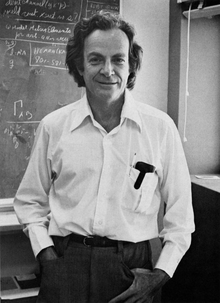
- 주요 업적
맨해튼 프로젝트
음파 방정식
베테-파인만 공식
파인만 바둑판
파인만 도형
파인만 개이지
파인먼-카츠 공식
파인만 매개변수화
파인만 포인트
파인만 전파자
파인만 슬래시 표기법
파인만 스프링클러
헬만-파인만 정리
헤비사이드-파인만 공식
V−A 이론
브라운 래칫
파인만-스투켈베르그 해석
나노 기술
단일 전자 우주
쪽입자
경로적분
봉고 연주
양자 세포 오토마타
양자 컴퓨터
양자 세포 자동화
양자 소산
양자전기역학
양자 유체역학
양자 논리 게이트
양자 난류
리주메이션
로저스 위원회
샤프트 패서
끈끈한 구슬 논쟁
합성 분자 모터
《파인만의 물리학 강의》
범용 양자 시뮬레이터
소용돌이 링 모형
휠러-파인만 흡수체 이론
변동 섭동 이론
- 수상
알베르트 아인슈타인 상 (1954)
E. O. 로렌스상 (1962)
노벨 물리학상 (1965)
왕립학회 외국인 회원 (1965)
외르스테드 메달 (1972)
미국 과학 메달 (1979)

○ 평가
꾸밈없고 직선적인 미국인 특유의 분위기를 지닌 학자로서 20세기를 살아간 물리학자 가운데 가장 유명한 인물로 손꼽힌다.
아인슈타인 이후 20세기 최고의 천재 물리학자 (브라이언 그린)로 평가되는 미국의 과학자다.
뉴욕 출신으로 2차대전 중에는 원자폭탄 제작에 참여하기도 했다.
양자 전기 역학 이론을 개발한 공로로 1965년에 노벨 물리학상을 공동 수상했다.
○ 일화
리처드 파인만은 전공인 물리학뿐만 아니라 그 외의 여러 분야에서도 타고난 호기심을 발휘하여 여러 가지 재미있는 에피소드를 낳기도 했다.
가령, 동료 과학자들의 금고를 열고 비밀문서를 몰래 꺼내는 장난질에서부터, 취미로 시작한 봉고 연주는 브라질 삼바 축제에 밴드로 참여할 만큼 수준급이었으며, 나이 들어서 시작한 그림 그리기나 고대 마야의 상형문자 연구, 그리고 심지어는 중앙아시아의 작은 나라 투바에 이르는 모험까지, 그의 전설적인 에피소드는 국내에도 번역 출간된 ‘파인만씨, 농담도 잘하시네!’와 ‘미스터 파인만!’이란 두 권의 책에 잘 나와 있다.
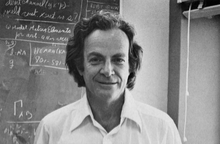
○ 저서
주요 저서로는 『파인만 씨, 농담도 잘하시네! : Surely You’re Joking, Mr. Feynman』, 『남이야 뭐라 하건! : What Do You Care What Other People Think?』, 『파인만의 여섯 가지 물리학 강의 : Six Easy Pieces』, 『발견하는 즐거움 : The Pleasure of Finding Things Out』 등이 있다.
*Bibliography
- Selected scientific works
Feynman, Richard P. (1942). Laurie M. Brown (ed.). The Principle of Least Action in Quantum Mechanics. PhD Dissertation, Princeton University. World Scientific (with title “Feynman’s Thesis: a New Approach to Quantum Theory”) (published 2005).
Wheeler, John A.; Feynman, Richard P. (1945). “Interaction with the Absorber as the Mechanism of Radiation”. Reviews of Modern Physics. 17 (2–3): 157–181. Bibcode:1945RvMP…17..157W. doi:10.1103/RevModPhys.17.157.
Feynman, Richard P. (1946). A Theorem and its Application to Finite Tampers. Los Alamos Scientific Laboratory, Atomic Energy Commission.
Feynman, Richard P.; Welton, T. A. (1946). Neutron Diffusion in a Space Lattice of Fissionable and Absorbing Materials. Los Alamos Scientific Laboratory, Atomic Energy Commission.
Feynman, Richard P.; Metropolis, N.; Teller, E. (1947). Equations of State of Elements Based on the Generalized Fermi-Thomas Theory (PDF). Los Alamos Scientific Laboratory, Atomic Energy Commission.
Feynman, Richard P. (1948). “Space-time approach to non-relativistic quantum mechanics”. Reviews of Modern Physics. 20 (2): 367–387. Bibcode:1948RvMP…20..367F.
Feynman, Richard P. (1948). “A Relativistic Cut-Off for Classical Electrodynamics”. Physical Review. 74 (8): 939–946. Bibcode:1948PhRv…74..939F.
Feynman, Richard P. (1948). “Relativistic Cut-Off for Quantum Electrodynamics”. Physical Review. 74 (10): 1430–1438. Bibcode:1948PhRv…74.1430F.
Wheeler, John A.; Feynman, Richard P. (1949). “Classical Electrodynamics in Terms of Direct Interparticle Action” (PDF). Reviews of Modern Physics. 21 (3): 425–433. Bibcode:1949RvMP…21..425W.
Feynman, Richard P. (1949). “The theory of positrons”. Physical Review. 76 (6): 749–759.
Feynman, Richard P. (1949). “Space-Time Approach to Quantum Electrodynamic”. Physical Review. 76 (6): 769–789.
Feynman, Richard P. (1950). “Mathematical formulation of the quantum theory of electromagnetic interaction”. Physical Review. 80 (3): 440–457.
Feynman, Richard P. (1951). “An Operator Calculus Having Applications in Quantum Electrodynamics”. Physical Review. 84 (1): 108–128.
Feynman, Richard P. (1953). “The λ-Transition in Liquid Helium”. Physical Review. 90 (6): 1116–1117.
Feynman, Richard P.; de Hoffmann, F.; Serber, R. (1955). Dispersion of the Neutron Emission in U235 Fission. Los Alamos Scientific Laboratory, Atomic Energy Commission.
Feynman, Richard P. (1956). “Science and the Open Channel”. Science (published February 24, 1956). 123 (3191): 307.
Cohen, M.; Feynman, Richard P. (1957). “Theory of Inelastic Scattering of Cold Neutrons from Liquid Helium”. Physical Review. 107 (1): 13–24.
Feynman, Richard P.; Vernon, F. L.; Hellwarth, R. W. (1957). “Geometric representation of the Schrödinger equation for solving maser equations” (PDF). J. Appl. Phys. 28 (1): 49.
Feynman, Richard P. (1959). “Plenty of Room at the Bottom”. Presentation to American Physical Society. Archived from the original on February 11, 2010.
Edgar, R. S.; Feynman, Richard P.; Klein, S.; Lielausis, I.; Steinberg, C. M. (1962). “Mapping experiments with r mutants of bacteriophage T4D”. Genetics (published February 1962). 47 (2): 179–86.
Feynman, Richard P. (1968) [1966]. “What is Science?”. The Physics Teacher. 7 (6): 313–320. Retrieved December 15, 2016. Lecture presented at the fifteenth annual meeting of the National Science Teachers Association, 1966 in New York City
Feynman, Richard P. (1966). “The Development of the Space-Time View of Quantum Electrodynamics”. Science (published August 12, 1966). 153 (3737): 699–708.
Feynman, Richard P. (1974a). “Structure of the proton”. Science. American Association for the Advancement of Science (published February 15, 1974). 183 (4125): 601–610.
Feynman, Richard P. (1974). “Cargo Cult Science” (PDF). Engineering and Science. 37 (7).
Feynman, Richard P.; Kleinert, Hagen (1986). “Effective classical partition functions” (PDF). Physical Review A (published December 1986). 34 (6): 5080–5084.
Feynman, Richard P. (1986). Rogers Commission Report, Volume 2 Appendix F – Personal Observations on Reliability of Shuttle. NASA.
Feynman, Richard P. (1988), “Difficulties in Applying the Variational Principle to Quantum Field Theories”, in L. Polley and D.E.L. Pottinger (ed.), Variational Calculations in Quantum Field Theory, World Scientific (published August 1, 1988), pp. 28–40, Proceedings of the International Workshop at Wangerooge Island, Germany; Sept 1–4, 1987
Feynman, Richard P. (2000). Laurie M. Brown (ed.). Selected Papers of Richard Feynman: With Commentary. 20th Century Physics. World Scientific.
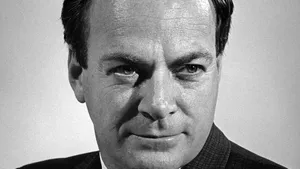
- Textbooks and lecture notes
The Feynman Lectures on Physics is perhaps his most accessible work for anyone with an interest in physics, compiled from lectures to Caltech undergraduates in 1961–1964. As news of the lectures’ lucidity grew, professional physicists and graduate students began to drop in to listen. Co-authors Robert B. Leighton and Matthew Sands, colleagues of Feynman, edited and illustrated them into book form. The work has endured and is useful to this day. They were edited and supplemented in 2005 with Feynman’s Tips on Physics: A Problem-Solving Supplement to the Feynman Lectures on Physics by Michael Gottlieb and Ralph Leighton (Robert Leighton’s son), with support from Kip Thorne and other physicists.
Feynman, Richard P.; Leighton, Robert B.; Sands, Matthew (2005) [1970]. The Feynman Lectures on Physics: The Definitive and Extended Edition (2nd ed.). Addison Wesley. Includes Feynman’s Tips on Physics (with Michael Gottlieb and Ralph Leighton), which includes four previously unreleased lectures on problem solving, exercises by Robert Leighton and Rochus Vogt, and a historical essay by Matthew Sands. Three volumes; originally published as separate volumes in 1964 and 1966.
Feynman, Richard P. (1961). Theory of Fundamental Processes. Addison Wesley.
Feynman, Richard P. (1962). Quantum Electrodynamics. Addison Wesley.
Feynman, Richard P.; Hibbs, Albert (1965). Quantum Mechanics and Path Integrals. McGraw Hill.
Feynman, Richard P. (1967). The Character of Physical Law: The 1964 Messenger Lectures. MIT Press.
Feynman, Richard P. (1972). Statistical Mechanics: A Set of Lectures. Reading, Mass: W. A. Benjamin.
Feynman, Richard P. (1985b). QED: The Strange Theory of Light and Matter. Princeton University Press.
Feynman, Richard P. (1987). Elementary Particles and the Laws of Physics: The 1986 Dirac Memorial Lectures. Cambridge University Press.
Feynman, Richard P. (1995). Brian Hatfield (ed.). Lectures on Gravitation. Addison Wesley Longman.
Feynman, Richard P. (1997). Feynman’s Lost Lecture: The Motion of Planets Around the Sun (Vintage Press ed.). London: Vintage.
Feynman, Richard P. (2000). Tony Hey and Robin W. Allen (ed.). Feynman Lectures on Computation. Perseus Books Group.
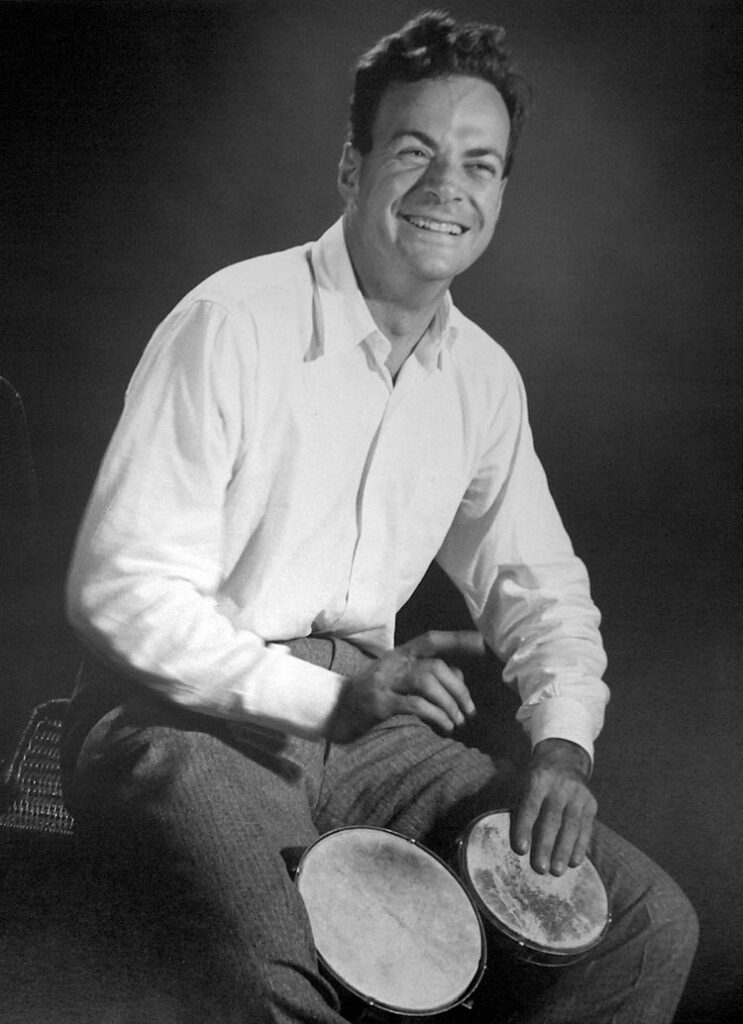
- Popular works
Feynman, Richard P. (1985). Ralph Leighton (ed.). Surely You’re Joking, Mr. Feynman!: Adventures of a Curious Character. W. W. Norton & Co.
Feynman, Richard P. (1988a). Ralph Leighton (ed.). What Do You Care What Other People Think?: Further Adventures of a Curious Character. W. W. Norton & Co.
No Ordinary Genius: The Illustrated Richard Feynman, ed. Christopher Sykes, W. W. Norton & Co, 1996.
Six Easy Pieces: Essentials of Physics Explained by Its Most Brilliant Teacher, Perseus Books, 1994, Listed by the Board of Directors of the Modern Library as one of the 100 best nonfiction books.
Six Not So Easy Pieces: Einstein’s Relativity, Symmetry and Space-Time, Addison Wesley, 1997.
Feynman, Richard P. (1998). The Meaning of It All: Thoughts of a Citizen Scientist. Reading, Massachusetts: Perseus Publishing.
Feynman, Richard P. (1999). Robbins, Jeffrey (ed.). The Pleasure of Finding Things Out: The Best Short Works of Richard P. Feynman. Cambridge, Massachusetts: Perseus Books.
Classic Feynman: All the Adventures of a Curious Character, edited by Ralph Leighton, W. W. Norton & Co, 2005, Chronologically reordered omnibus volume of Surely You’re Joking, Mr. Feynman! and What Do You Care What Other People Think?, with a bundled CD containing one of Feynman’s signature lectures.
- Audio and video recordings
Safecracker Suite (a collection of drum pieces interspersed with Feynman telling anecdotes)
Los Alamos From Below (audio, talk given by Feynman at Santa Barbara on February 6, 1975)
Six Easy Pieces (original lectures upon which the book is based)
Six Not So Easy Pieces (original lectures upon which the book is based)
The Feynman Lectures on Physics: The Complete Audio Collection
Samples of Feynman’s drumming, chanting and speech are included in the songs “Tuva Groove (Bolur Daa-Bol, Bolbas Daa-Bol)” and “Kargyraa Rap (Dürgen Chugaa)” on the album Back Tuva Future, The Adventure Continues by Kongar-ool Ondar. The hidden track on this album also includes excerpts from lectures without musical background.
The Messenger Lectures, given at Cornell in 1964, in which he explains basic topics in physics. Available on Project Tuva free.
Take the world from another point of view [videorecording] / with Richard Feynman; Films for the Hu (1972)
The Douglas Robb Memorial Lectures, four public lectures of which the four chapters of the book QED: The Strange Theory of Light and Matter are transcripts. (1979)
The Pleasure of Finding Things Out, BBC Horizon episode (1981) (not to be confused with the later published book of the same title)
Richard Feynman: Fun to Imagine Collection, BBC Archive of six short films of Feynman talking in a style that is accessible to all about the physics behind common to all experiences. (1983)
Elementary Particles and the Laws of Physics (1986)
Tiny Machines: The Feynman Talk on Nanotechnology (video, 1984)
Computers From the Inside Out (video)
Quantum Mechanical View of Reality: Workshop at Esalen (video, 1983)
Idiosyncratic Thinking Workshop (video, 1985)
Bits and Pieces—From Richard’s Life and Times (video, 1988)
Strangeness Minus Three (video, BBC Horizon 1964)
No Ordinary Genius (video, Cristopher Sykes Documentary)
Richard Feynman—The Best Mind Since Einstein (video, Documentary)
The Motion of Planets Around the Sun (audio, sometimes titled “Feynman’s Lost Lecture”)
Nature of Matter (audio)

참고 = 위키백과
크리스천라이프 편집부
